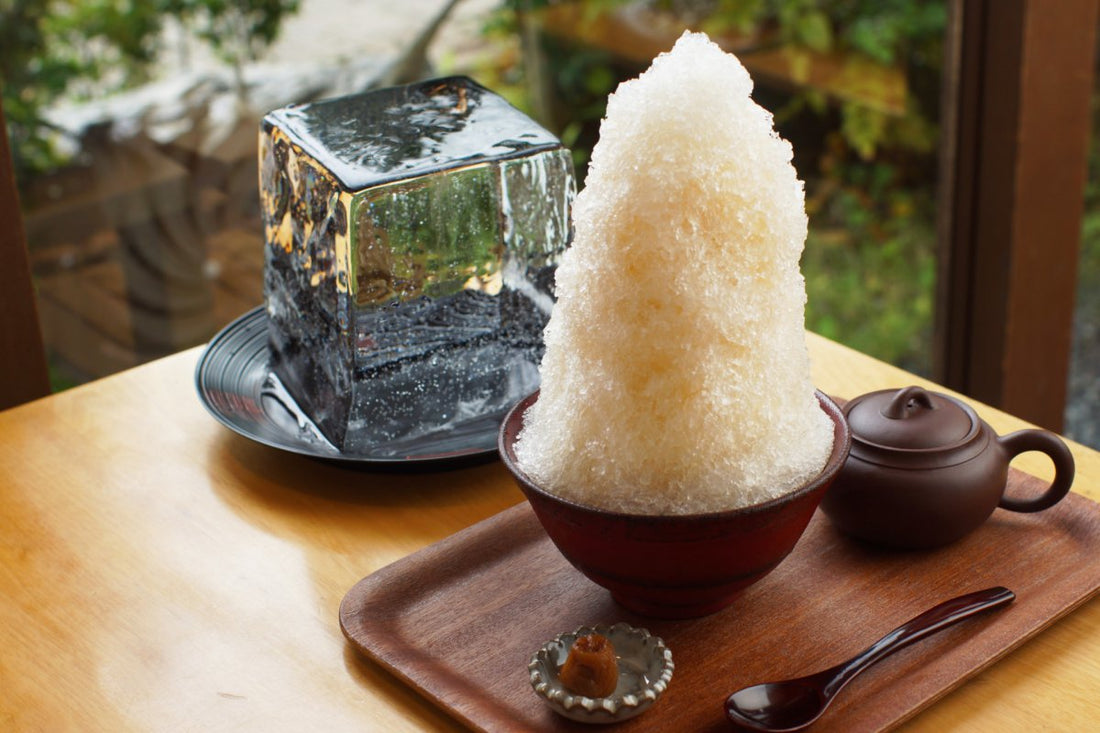
The history and origin of kakigori
in short
- Noble origins: Kakigori began in the Heian period (794–1185), enjoyed exclusively by aristocrats using ice stored in caves.
- From elite to everyday: By the Meiji era, advances in ice production made shaved ice accessible to the public.
- Post-war changes: Refrigeration spread kakigori nationwide, with machines and artificial syrups simplifying preparation.
- Modern revival: Today, artisanal kakigori emphasizes natural spring ice and fresh fruit syrups.
- Global influence: Kakigori inspired similar desserts worldwide, like Korean bingsu and Filipino halo-halo.
- Timeless symbol: Each serving connects past traditions with modern innovation, celebrating summer in Japan.
Kakigori, a delightful dessert from Japan, is an essential part of the country's culinary culture. This refreshing treat, made of finely shaved ice and often adorned with colorful syrups and sweetened condensed milk, is not just a dessert but a symbol of summer in Japan. However, the origins and history of kakigori stretch far back, more than a thousand years ago, when it was a luxury reserved for the elite. Let's embark on a journey to discover the rich history and fascinating origins of this beloved icy treat.
A Dessert of Noble Origins
The roots of kakigori date back to the Heian Period (794-1185), a time when Japan was experiencing significant cultural growth and development. The first written account of kakigori was found in "Makura no Sōshi" (枕草子), a collection of essays by Sei Shōnagon, a lady in the imperial court. It describes how the aristocrats would store natural ice in insulated caves, known as "himuro" or "ice rooms," during the winter. This ice was then shaved and served with sweet sap and fruit juices, a luxury only the nobility could afford.
From Royal Treat to People's Dessert
Kakigori remained a dessert for the privileged until the Meiji era (1868-1912) when ice became more widely available thanks to advancements in ice production techniques. The dessert gradually became popular among the general public, and by the Taisho era (1912-1926), Japanese shave ice was a common sight at festivals and on the streets during the summertime. Small stalls would sell kakigori flavored with fruit syrups such as strawberry, lemon, and melon, establishing the dessert as a symbol of summer in Japan.
Post-War Transformation and the Modern Kakigori
The post-war period brought significant changes to kakigori. With the advent of refrigeration technology, ice became even more accessible, leading to an increase in kakigori's popularity. However, it was during the post-war period that artificial flavors and colors began to replace the natural ingredients in kakigori syrups. This period also saw the invention of the kakigori machine, making the preparation of the dessert even easier.
Fortunately, in recent decades, there has been a resurgence of the traditional methods and flavors. Many kakigori shops now strive to use natural syrups made from seasonal fruits and source their ice from natural springs. This return to the old ways has ushered in the era of "artisanal kakigori."
A Global Phenomenon

However, no matter where it is served or what form it takes, the essence of kakigori remains the same—a refreshing, sweet treat that offers a moment of cool respite on a hot summer day. This enduring appeal, rooted in its rich history and origins, is a testament to kakigori's timeless charm.
From its humble beginnings in the imperial court to its widespread popularity today, kakigori has become more than just a dessert—it's a symbol of summer, a cherished tradition, and a sweet slice of Japanese culture. As the ice melts in your mouth and the sweet syrup leaves a lingering taste, remember the centuries-old tradition that has allowed this simple yet delightful treat to reach your hands.
A Connection to Japan's Past
When you take a bite of kakigori, it's not just the ice and syrup you're tasting, but a rich piece of Japan's cultural history. It's a dessert that has withstood the test of time and has adapted through the centuries, reflecting the changes in society and technology. Every spoonful of kakigori is a connection to Japan's past, a nod to the ingenuity of the Heian aristocrats, the resilience of the Meiji populace, and the innovation of the modern era.
Despite its transformations, the heart of kakigori remains the same—a delightful treat that captures the essence of summer in Japan. And as we move towards the future, it's exciting to think about how this timeless dessert will continue to evolve while still maintaining its sweet, historic core.
Embracing the Future of Kakigori
The journey of kakigori, from the imperial courts of the Heian period to the modern, bustling streets of Tokyo, is a testament to its enduring appeal. As we look forward to the future of kakigori, we see a resurgence in its traditional methods with an emphasis on natural, high-quality ingredients. But we also see innovation with new flavors, techniques, and presentation styles that keep this age-old dessert exciting and relevant.
In every scoop of delicately shaved ice, every drizzle of vibrant syrup, and every dollop of sweetened condensed milk, we see a dessert that has bridged the old with the new, the traditional with the innovative. And that, in essence, is the beauty of Japanese shaved ice, a dessert that is as timeless as it is ever-evolving.
Conclusion
So, the next time you enjoy a bowl of kakigori, remember the rich history and cultural significance that comes with each bite. Whether it's a simple street stall serving the classic strawberry kakigori or a high-end dessert shop offering a gourmet variation, you're partaking in a tradition that spans centuries. And as you savor the cool, sweet flavors, remember that you're not just enjoying a dessert, you're experiencing a part of Japan's vibrant and flavorful history.
